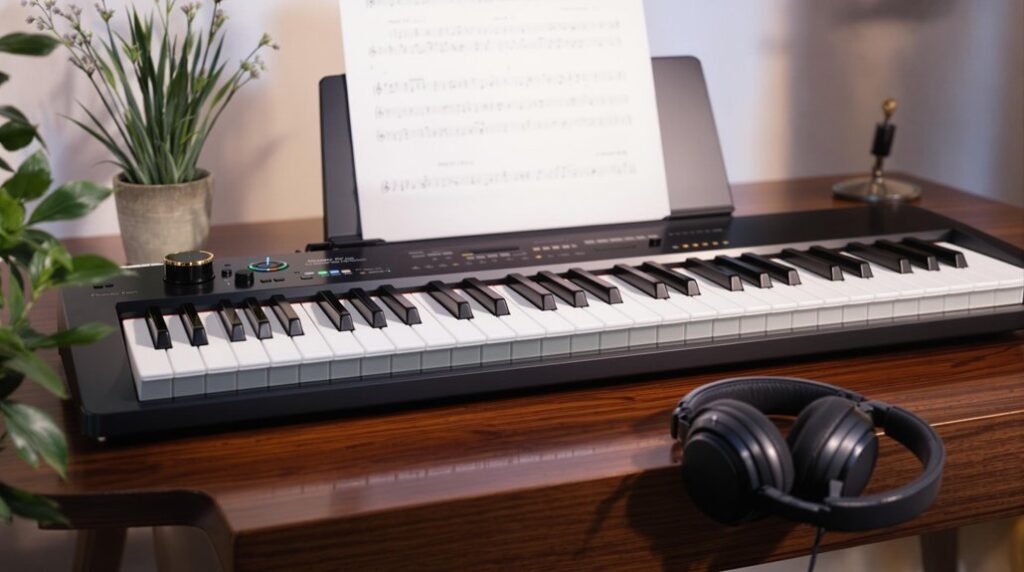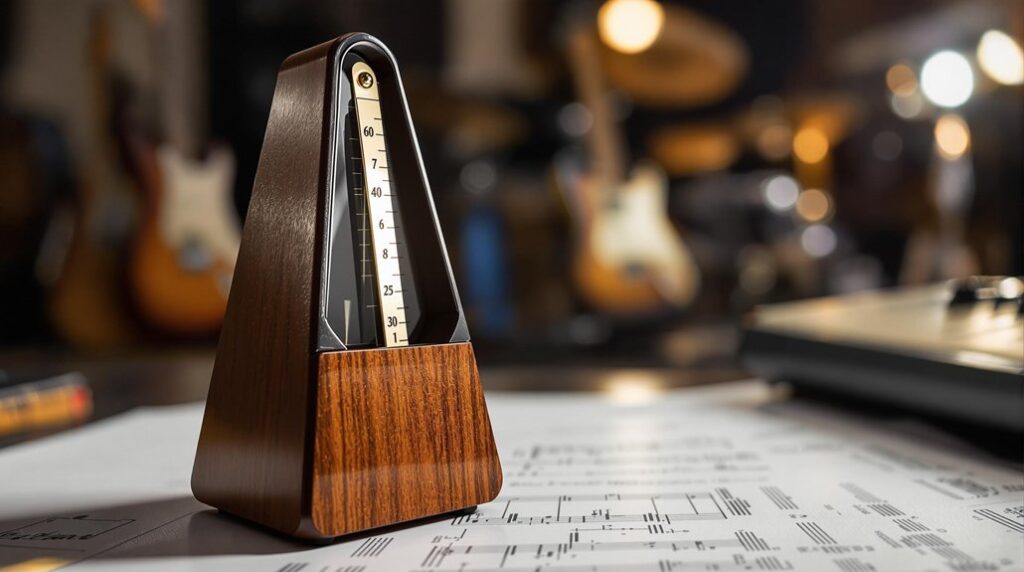Writing and analyzing a fugue involve intricate contrapuntal techniques and a thorough understanding of its structured form. A fugue revolves around the subject, developed through the exposition with each voice sequentially presenting it, often accompanied by a countersubject. Episodes intersperse these entries, utilizing fragmentation and sequencing for thematic exploration. Essential technical elements include strict voice leading, avoidance of parallel octaves, and the use of tonal or real answers to maintain harmonic coherence. Mastery of these aspects guarantees a methodical yet dynamic flow, deepening one’s grasp of the fugue’s sophisticated design and the underlying theoretical principles. Engage further to explore multifaceted insights into these techniques.
Key Takeaways
- Choose a robust subject capable of extensive contrapuntal development.
- Introduce the subject in each voice during the exposition, followed by tonal or real answers.
- Utilize episodes with fragmentation and sequencing for thematic exploration and development.
- Maintain voice independence by avoiding parallel octaves and adhering to strict counterpoint rules.
- Analyze harmonic techniques focusing on tonic-dominant relationships and seamless key modulations.
Definition of Fugue
A fugue, by definition, is a highly structured contrapuntal composition that meticulously develops a primary melodic idea known as the subject. The fugue characteristics are inherently bound to its contrapuntal techniques, where the subject is introduced and elaborated upon through multiple voices.
The initial presentation of the subject occurs during the exposition. Here, each voice sequentially states the subject, initiating a polyphonic dialogue. This is succeeded by the answer, which can be either a tonal answer, adjusting intervals to align with the new key, or a real answer, preserving the original intervals.
One of the defining fugue characteristics is the use of a countersubject. This is a consistent counterpoint that often accompanies each occurrence of the subject, thereby enriching the textural complexity.
Throughout the fugue, episodes serve as developmental interludes, utilizing techniques like fragmentation and sequencing. These contrapuntal techniques provide contrast and variation, ensuring that the composition remains dynamic and engaging.
Fugue Structure
Understanding the definition of a fugue provides a foundation for examining its intricate structure. Central to the fugue’s architecture are the principles of voice leading and thematic development. The fugue typically unfolds in the following manner:
- Exposition: The fugue begins with the exposition where each voice introduces the subject in succession. This phase establishes the thematic material, with subsequent voices presenting the subject or its answer in the dominant key, ensuring melodic integrity.
- Answer and Countersubject: The second voice presents the answer, a transposition of the subject to the dominant key. This is often accompanied by a countersubject, which consistently appears alongside the subject, enhancing the contrapuntal texture.
- Episodes: Following the exposition, the fugue shifts into episodes. These sections develop the thematic material through techniques such as motivic fragmentation and sequencing, which provide contrast and maintain listener interest.
- Entries and Episodes Alternation: The structure alternates between entries (full statements of the subject) and episodes. This alternation generates a dynamic flow, building tension and leading to a climactic resolution.
Thus, the fugue’s structure, characterized by meticulous voice leading and thematic development, creates an engaging and intellectually stimulating musical form.
Components of Fugue
Delving into the components of a fugue reveals the intricate mechanisms that drive its contrapuntal complexity. Central to this structure is the subject, the primary melodic idea that forms the foundation of the entire composition. The subject is introduced at the outset and serves as the thematic anchor throughout the fugue.
Following the initial statement of the subject, the answer emerges. This is the second voice’s rendition of the subject, typically transposed to the dominant key. Depending on the harmonic context, the answer may be a tonal answer—adjusted to fit the key—or a real answer, an exact transposition.
A significant element in maintaining the contrapuntal texture is the countersubject. This secondary melody consistently accompanies the subject, enriching the texture and facilitating motivic development.
Shifts between subject entries are often facilitated by a bridge. This modulatory passage guarantees smooth shifts, maintaining coherence within the piece.
Lastly, although episodes are not the focus here, it is essential to understand their role in thematic exploration and contrast through the fragmentation and sequencing of the subject.
Each component, consequently, contributes to the overall complexity and sophistication inherent in fugue composition.
Expositions and Episodes
Expositions and episodes form the structural backbone of a fugue, delineating its thematic and developmental phases. The exposition introduces the fugue’s main thematic material by presenting the subject in all voices at least once. Each subsequent entry, known as a middle entry, restates the subject in various voices, creating a dynamic subject interplay that enhances development and contrast.
Episodes, in contrast, do not present the full subject but focus on episode development through techniques such as fragmentation and sequencing. These sections provide a necessary respite from the intense thematic exposition, allowing for the exploration and transformation of motives.
The bridge, connecting the answer to subsequent subject statements, guarantees smooth shifts and maintains structural coherence.
Key elements to take into account in expositions and episodes include:
- Subject Interplay: The restatement of the subject in different voices during middle entries.
- Episode Development: The use of fragmentation and sequencing to develop material.
- Bridge: Connecting passages linking answers to subsequent subject statements.
- Motivic Fragmentation: The breaking down of subjects and countersubjects to enhance musical complexity.
Understanding these components is fundamental for analyzing and composing fugues, as they contribute to the work’s overall textual and formal sophistication.
Writing a Fugue
Crafting a compelling fugue requires meticulous attention to its foundational elements, starting with the selection of a robust subject. This subject must be engaging and capable of extensive contrapuntal development, enduring various treatments and transformations. The exposition introduces the subject in each voice sequentially, ensuring harmonic integrity through tonal and real answers.
| Element | Description |
|---|---|
| Subject | The main theme introduced and developed throughout the fugue |
| Exposition | Initial presentation of the subject by all voices in order |
| Countersubject | A secondary theme that accompanies the subject, enhancing contrapuntal texture |
| Episodes | Sections that explore fragmentations and sequences of the subject |
| Voice Leading | Techniques used to maintain harmonic clarity and smooth shifts |
Incorporating a well-crafted countersubject is vital, as it provides a consistent companion to the subject, enriching the fugue’s contrapuntal texture. Episodes, featuring motivic fragmentation and sequencing, offer developmental space and contrast, preventing monotony. Finally, precise voice leading and harmonic shifts are essential for maintaining structural clarity and coherence. By meticulously balancing these elements, one can achieve a fugue that is both intellectually stimulating and aesthetically pleasing.
Technical Considerations
In crafting a fugue, it is imperative to meticulously define and avoid parallel octaves, which can compromise the independence of the individual voices.
The selection of harmonic answers must be judicious, ensuring that they reinforce the fugue’s structural integrity while maintaining tonal stability.
Maintaining a robust tonal foundation, particularly through the strategic use of tonic and dominant relationships, is essential for sustaining listener engagement and coherence throughout the composition.
Parallel Octaves Definition
Why is the consideration of parallel octaves so critical in the composition of a fugue? In the domain of advanced counterpoint techniques, parallel octaves involve two voices moving in parallel motion by the same interval, resulting in a similar pitch relationship. This can notably diminish the independence of the voices, a cornerstone of fugue writing.
Hidden parallel octaves, where such motion is obscured by other voices or harmonic structures, also pose a threat to the integrity of the contrapuntal texture.
To guarantee the clarity and separation between voices, composers must diligently avoid parallel octaves, particularly during the exposition. However, exceptions can be made in later sections of the piece where the texture might allow for more flexibility.
The scrutiny of parallel octaves is essential due to their potential to weaken the contrapuntal structure, compelling composers to employ alternative counterpoint techniques to maintain interest and complexity.
Key considerations include:
- Voice Independence: Avoid parallel octaves to preserve the distinct character of each voice.
- Textural Clarity: Hidden parallel octaves can obscure the texture, reducing transparency.
- Contrapuntal Integrity: Maintaining strict counterpoint rules safeguards the fugue’s intricate structure.
- Compositional Flexibility: While generally discouraged, parallel octaves can be strategically employed post-exposition.
Harmonic Answer Choices
Choosing the appropriate harmonic answer for a fugue subject is a critical decision that can shape the overall tonal architecture of the piece. Traditionally, answers can be categorized as real or tonal. A real answer preserves the exact intervals of the subject, while a tonal answer modifies certain intervals to fit the harmonic context, typically emphasizing the dominant key. The choice between these answers carries significant harmonic implications, directly influencing the fugue’s structural cohesion.
While dominant tonal answers are commonly employed to establish a strong tonal foundation, modal answers are less frequent due to their potential ineffectiveness in reinforcing a clear tonal center. The harmonic implications of using a modal answer can lead to ambiguity, which might detract from the listener’s engagement.
In the exposition, adherence to tonal answers is generally recommended to solidify the fugue’s central tonality. However, deviation from strict rules becomes more permissible as the fugue progresses. This flexibility allows composers to explore creative possibilities while maintaining overall coherence.
Ultimately, the strategic selection of harmonic answers is paramount for constructing a fugue that is both technically sound and artistically compelling.
Tonal Stability Maintenance
The selection of harmonic answers directly impacts the preservation of tonal stability in a fugue, as it sets the groundwork for the overall tonal framework.
Maintaining tonal stability is vital for creating a cohesive and engaging musical structure, which is typically achieved through the clear establishment of tonic and dominant relationships in the exposition.
Adhering to this standard pattern is imperative; deviations can confuse listeners and disrupt the flow, undermining both tonal clarity and harmonic coherence.
To maintain tonal stability:
- Establish Clear Tonic and Dominant Relationships: Confirm that the exposition firmly anchors the tonic and dominant areas, avoiding any ambiguity.
- Avoid Modal Answers: While tonal answers are traditional, modal answers are rare and often introduce unwanted harmonic ambiguities that can erode tonal clarity.
- Adhere to Tonal Foundations Outside the Exposition: Minor variations in restating the subject are permissible, but maintaining a strong overall tonal foundation is vital for listener engagement.
- Carefully Choose Harmonic Answers: The choice between tonal and real answers plays a significant role in preserving the fugue’s structural integrity and maintaining a strong central tonality.
Harmonic Analysis
Harmonic analysis in fugue centers on the intricate tonal relationships, especially the interplay between tonic and dominant functions, which are established in the exposition and rigorously maintained throughout.
A critical aspect is the examination of modulatory passages that shift between keys, often facilitated by tonal answers that adjust intervallic content or real answers that preserve the subject’s exact intervals.
This analysis extends to episodes where harmonic variations and motivic fragmentation enhance structural coherence and emotional depth.
Tonal Harmony in Fugues
In the intricate architecture of fugue composition, tonal harmony serves as the bedrock upon which the entire structure is built. Central to this is the initial presentation of the subject in the tonic key, followed by its answer in the dominant key, establishing a robust tonal foundation.
The use of tonal answers, which allow for slight alterations in intervals, helps maintain the subject’s identity while facilitating smoother harmonic shifts compared to real answers. This careful balance enhances the thematic cohesion and guarantees the listener remains engaged.
Key Elements of Tonal Harmony in Fugues:
- Tonic-Dominant Pattern: The exposition typically follows a tonic-dominant harmonic progression, reinforcing tonal stability and engaging the listener.
- Tonal Answers vs. Real Answers: Tonal answers introduce slight intervallic changes, aiding in harmonic modulation while preserving the subject’s essence.
- Subdominant Avoidance: Subdominant tonal answers are rare, as they can introduce instability, detracting from the fugue’s overall cohesion.
- Effective Modulation: Strategic harmonic modulation during episodes helps develop themes further and maintains interest by shifting through different keys, subtly referencing the subject.
Analyzing Modulatory Passages
Modulatory passages, integral to the dynamic progression of a fugue, serve as essential bridges that weave together different thematic statements while ensuring smooth key shifts. Effective harmonic analysis of these sections requires a meticulous examination of modulatory techniques, focusing on pivot chords that facilitate seamless changes between keys. These pivot chords often employ common tones or chromatic alterations to maintain tonal coherence.
Attention to voice leading within modulatory passages is vital. Proper handling of dissonances and resolutions can enhance the overall flow, ensuring that the fugue’s harmonic exploration remains fluid and engaging. Frequently, modulations to closely related keys, such as the dominant or subdominant, are employed. This practice preserves thematic continuity while providing a sense of movement that captivates the listener.
Motivic development plays a significant role in these passages, as fragments of the subject or countersubject are often reworked to create cohesion throughout the piece. By recognizing and analyzing these elements, one gains a deeper understanding of how modulatory passages contribute to the structural and thematic integrity of a fugue.
Careful study of these techniques reveals the intricate balance between innovation and adherence to tonal principles that defines masterful counterpoint.
Community Feedback
Engaging with community members for feedback on fugue compositions offers invaluable opportunities to uncover overlooked aspects and gain fresh perspectives on counterpoint techniques.
Community engagement through feedback sessions, peer reviews, and collaborative workshops enhances both the quality and depth of fugue writing. Constructive criticism from peers is instrumental in identifying areas needing improvement, thereby refining the compositional process.
The key advantages of community feedback can be summarized as follows:
- Constructive Criticism: Peer reviews provide actionable insights, helping composers recognize flaws and refine their techniques.
- Diverse Perspectives: Composition sharing within a community allows for varied interpretations, enriching the learning experience through musical dialogue.
- Collaborative Workshops: Working with experienced composers in workshops fosters growth and a deeper understanding of complex fugue structures.
- Avoiding Common Pitfalls: Utilizing feedback and historical examples guides composers in circumventing common errors, leading to more polished fugue compositions.
Incorporating these elements into the creative process guarantees a well-rounded, thorough approach to fugue writing.
Historical Context
The fugue, a cornerstone of Western classical music, traces its origins to the Renaissance and Baroque periods, where it evolved into a complex and expressive form under the hands of master composers such as Johann Sebastian Bach.
Early indications of fugue-like structures can be observed in the works of Giovanni Gabrieli and the Venetian school during the late 16th century. This era saw the flourishing of polyphonic textures, a direct result of Renaissance influences that emphasized interwoven melodic lines.
Entering the 17th century, the development of figured bass and the establishment of tonality greatly impacted the Baroque evolution of the fugue. These innovations allowed for more structured expositions and episodes, providing a framework within which composers could explore intricate counterpoint.
The term “fugue” itself, derived from the Latin “fuga” meaning “flight,” aptly describes the interweaving of musical lines that define the form.
The study of fugue became integral to music education in the 18th and 19th centuries, championed by figures such as Carl Philipp Emanuel Bach. This period solidified the fugue’s role in mastering counterpoint, thereby ensuring its lasting importance in the canon of Western classical music.
Practical Exercises
Understanding the historical context of the fugue provides a solid foundation for engaging with its practical exercises. To master the intricate art of writing and analyzing fugues, one must systematically approach various facets of counterpoint practice and melodic interaction.
Below are essential fugue exercises designed to enhance your proficiency in this sophisticated compositional form:
- Subject Internalization: Practice singing or playing the fugue subject repeatedly to internalize its melodic structure. This familiarity is vital before attempting to compose entries or develop counterpoint.
- Voice Tracking and Notation: Track and notate each voice’s entry in a fugue. This exercise aids in comprehending the interaction between the subject and countersubject, thereby elucidating their respective roles within the composition.
- Episode Analysis: Analyze episodes by identifying fragments of the subject and countersubject. Note how these elements contribute to the overall texture and flow, consequently enhancing your understanding of episodic development.
- Climax Identification: Conduct a climax identification exercise by pinpointing the moments where the music reaches its highest emotional impact. Analyze how these climaxes resolve to understand the structural and emotional architecture of the fugue.
Frequently Asked Questions
What Techniques Are Used in the Fugue?
In a fugue, techniques such as subject and answer interplay, countersubjects, episodes, and bridges facilitate thematic development. Motivic fragmentation allows for intricate subject matter manipulation, enhancing the fugue’s harmonic and melodic complexity.
Why Are Fugues Hard to Write?
Fugues are hard to write due to their inherent complexity and the creative challenges they present. Composers must expertly manage multiple voices, guarantee tonal stability, and balance thematic coherence with motivic fragmentation, requiring advanced counterpoint skills and meticulous planning.
What Is the Technique Used in the Performance of Fugue?
Fugue performance necessitates meticulous interpretative choices, emphasizing distinct articulation of each voice, dynamic contrasts, and phrasing. Musicians must balance tempo variations and motivic development, ensuring the subject and countersubject are clearly delineated within the contrapuntal texture.
How Do You Structure a Fugue?
Structuring a fugue involves an exposition introducing the subject in all voices, followed by subject development through alternating entries and episodes. This process, rich in key changes and textural complexity, sustains thematic interest and intricate counterpoint.
Conclusion
To sum up, mastering the art of writing and analyzing fugues requires a deep understanding of its structure, components, and the intricate interplay of voices. Advanced counterpoint techniques are essential for creating sophisticated expositions and episodes, while harmonic analysis provides critical insights into the compositional framework. Historical context and community feedback further enrich the learning process. By engaging in practical exercises, one can develop the skills necessary to both appreciate and compose fugues with scholarly precision.




